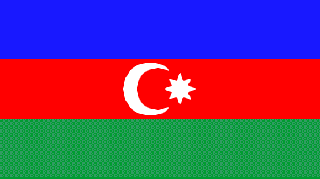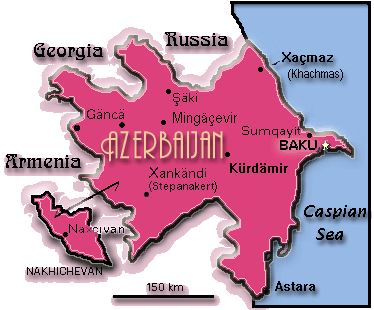Azerbaijan


Geography
Location: Southwestern Asia, between Armenia and Turkmenistan, bordering the Caspian SeaArea:
total area: 86,600 sq km
land area: 86,100 sq km
comparative area: slightly larger than Maine
note: includes the Nakhichevan Autonomous Republic and the Nagorno-Karabakh regions; regions' autonomy was abolished by Azerbaijani Supreme Soviet on 26 November 1991Land boundaries: total 2,013 km, Armenia (west) 566 km, Armenia (southwest)221 km, Georgia 322 km, Iran (south) 432 km, Iran (southwest) 179 km, Russia 284 km, Turkey 9 km
Coastline: 0 km (landlocked)
note: Azerbaijan borders the Caspian Sea (800 km, est.)Maritime claims: NA
note: Azerbaijani claims in Caspian Sea unknown; 10-nm fishing zone provided for in 1940 treaty regarding trade and navigation between Soviet Union and IranInternational disputes: violent and long-standing dispute with ethnic Armenians of Nagorno-Karabakh over its status,lesser dispute concerns Nakhichevan; some Azerbaijanis desire absorption of and/or unification with the ethnic Azeri portion of Iran
Climate: dry, semiarid steppe
Terrain: large, flat Kur-Araz Lowland (much of it below sea level) with Great Caucasus Mountains to the north, Qarabag (Karabakh) Upland in west; Baku lies on Abseron (Apsheron) Peninsula that juts into Caspian Sea
Natural resources: petroleum, natural gas, iron ore, nonferrous metals, alumina
Land use:
arable land: 18%
permanent crops: 4%
meadows and pastures: 25%
forest and woodland: 0%
other: 53%Irrigated land: 14,010 sq km (1990)
Environment:
current issues: local scientists consider the Abseron (Apsheron) Peninsula (including Baku and Sumqayit) and the Caspian Sea to be the ecologically most devastated area in the world because of severe air, water, and soil pollution; soil pollution results from the use of DDT as a pesticide and also from toxic defoliants used in the production of cotton
natural hazards: subject to drought; some coastal areas threatened by rising levels of the Caspian Sea
international agreements : signed, but not ratified - Biodiversity, Climate ChangeNote: landlocked
Azerbaijani News
People
Population: 7,684,456 (July 1994 est.)
Population growth rate: 1.41% (1994 est.)
Birth rate: 23.04 births/1,000 population (1994 est.)
Death rate: 6.58 deaths/1,000 population (1994 est.)
Net migration rate: -2.38 migrant(s)/1,000 population (1994 est.)
Infant mortality rate: 34.8 deaths/1,000 live births (1994 est.)
Life expectancy at birth:
total population: 70.85 years
male: 67.08 years
female : 74.8 years (1994 est.)Total fertility rate: 2.7 children born/woman (1994 est.)
Nationality:
noun: Azerbaijani(s)
adjective: AzerbaijaniEthnic divisions: Azeri 82.7%, Russian 5.6%, Armenian 5.6%, Dagestani 3.2%, other 2.9% (1989)
note: Armenian share is now approximately 0.3% because most Armenians have fled the ethnic violence since 1989 census; Russian percentage is probably half what it was for the same reasonReligions: Muslim 87%, Russian Orthodox 5.6%, Armenian Orthodox 5.6%, other 1.8%
Languages: Azeri 82%, Russian 7%, Armenian 5%, other 6%
Literacy: age 9-49 can read and write (1970)
total population : 100%
male: 100%
female: 100%Labor force: 2.789 million
by occupation: agriculture and forestry 32%, industry and construction 26%, other 42% (1990)
Government
Names:
conventional long form: Azerbaijani Republic
conventional short form: Azerbaijan
local long form : Azarbaycan Respublikasi
local short form: none
former: Azerbaijan Soviet Socialist RepublicDigraph: AJ
Type: republic
Capital: Baku (Baky)
Administrative divisions: 1 autonomous republic (avtomnaya respublika); Nakhichevan (administrative center at Nakhichevan)
note : all rayons except for the exclave of Nakhichevan are under direct republic jurisdictionIndependence: 30 August 1991 (from Soviet Union)
National holiday: Novruz Bayram, 21-22 March
Constitution: adopted NA April 1978; writing a new constitution mid-1993
Legal system: based on civil law system
Suffrage: 18 years of age; universal
Executive branch:
chief of state: President Heydar ALIYEV (since 18 June 1993 after President ELCIBEY left Baku for Nakhichevan); election last held 3 October 1993 (next to be held NA); results - Heydar ALIYEV won 97% of vote
head of government : Prime Minister Surat HUSEYNOV (since 30 June 1993)
cabinet: Council of Ministers; appointed by the president and confirmed by the MejlasLegislative branch: unicameral
National Assembly (Milli Mejlis) : elections last held 30 September and 14 October 1990 for the Supreme Soviet (next expected to be held NA 1994 for the National Assembly); seats for Supreme Soviet - (360 total) Communists 280, Democratic Bloc 45 (grouping of opposition parties), other 15, vacant 20; note - on 19 May 1992 the Supreme Soviet was prorogued in favor of a Popular Front-dominated National Council; seats - (50 total) Popular Front 25, opposition elements 25Judicial branch: Supreme Court
Political parties and leaders: Azerbaijan Popular Front (APF), Ebulfez ELCIBEY, chairman; Musavat Party, Isa GAMBAR, chairman; National Independence Party, Etibar MAMEDOV, chairman; Social Democratic Party (SDP), Araz ALIZADE, chairman; Communist Party, Ramiz AKHMEDOV, chairman; People's Freedom Party, Yunus OGUZ, chairman; Independent Social Democratic Party, Arif YUNUSOV and Leila YUNOSOVA, cochairmen; New Azerbaijan Party, Heydar ALIYEV, chairman; Boz Gurd Party, Iskander HAMIDOV, chairman; Azerbaijan Democratic Party, Sardar MAMEDOV, chairman; Azerbaijan Democratic Independence Party, Qabil HUSELNLI, chairman; Islamic Party of Azerbaijan, Ali Akram, chairman
Other political or pressure groups: self-proclaimed Armenian Nagorno-Karabakh Republic; Talysh independence movement
Member of: BSEC, CCC, CIS, CSCE, EBRD, ECE, ECO, ESCAP, IBRD, ICAO, IDB, ILO, IMF, INTELSAT, INTERPOL, IOC, ITU, NACC, OIC, UN, UNCTAD, UNESCO, UPU, WHO
Diplomatic representation in US:
chief of mission: Ambassador Hafiz Mir Jalal Ogly PASHAYEV
chancery: Suite 700, 927 15th Street NW, Washington, DC 20005
telephone: (202) 842-0001
FAX: (202) 842-0004US diplomatic representation:
chief of mission: Ambassador Richard KAZLAURICH
embassy: Hotel Intourist, Baku
mailing address : use embassy street address
telephone: 7-8922-92-63-06 through 09, extension 441, 442, 446, 447, 448, 450
FAX: Telex 142110 AMEMB SU
Economy
BISNIS Economic ReviewOverview: Azerbaijan is less developed industrially than either Armenia or Georgia, the other Transcaucasian states. It resembles the Central Asian states in its majority Muslim population, high structural unemployment, and low standard of living. The economy's most prominent products are oil, cotton, and gas. Production from the Caspian oil and gas field has been in decline for several years. With foreign assistance, the oil industry might generate the funds needed to spur industrial development. However, civil unrest, marked by armed conflict in the Nagorno-Karabakh region between Muslim Azeris and Christian Armenians, makes foreign investors wary. Azerbaijan accounted for 1.5% to 2% of the capital stock and output of the former Soviet Union. Azerbaijan shares all the formidable problems of the ex-Soviet republics in making the transition from a command to a market economy, but its considerable energy resources brighten its prospects somewhat. Old economic ties and structures have yet to be replaced. A particularly galling constraint on economic revival is the Nagorno-Karabakh conflict, said to consume 25% of Azerbaijan's economic resources.
National product: GDP - purchasing power equivalent - $15.5 billion (1993 estimate from the UN International Comparison Program, as extended to 1991 and published in the World Bank's World Development Report 1993; and as extrapolated to 1993 using official Azerbaijani statistics, which are very uncertain because of major economic changes since 1990)
National product real growth rate: -13.3% (1993 est.)
National product per capita: $2,040 (1993 est.)
Inflation rate (consumer prices): 20% per month (average 1993); above 50% per month (February 1994)
Unemployment rate: 0.7% includes officially registered unemployed; also large numbers of underemployed workers (December 1993)
Budget:
revenues: $NA
expenditures: $NA, including capital expenditures of $NAExports: $355 million to outside the FSU countries (f.o.b., 1993)
commodities: oil and gas, chemicals, oilfield equipment, textiles, cotton (1991)
partners: mostly CIS and European countriesImports: $240 million from outside the FSU countries (c.i.f., 1993)
commodities: machinery and parts, consumer durables, foodstuffs, textiles (1991)
partners: European countriesExternal debt: $NA
Industrial production: growth rate -7% (1993)
Electricity:
capacity: 6,025,000 kW
production: 22,300 kWh
consumption per capita: 2,990 kWh (1992)Industries: petroleum and natural gas, petroleum products, oilfield equipment; steel, iron ore, cement; chemicals and petrochemicals; textiles
Agriculture: cotton, grain, rice, grapes, fruit, vegetables, tea, tobacco; cattle, pigs, sheep and goats
Illicit drugs: illicit cultivator of cannabis and opium poppy; mostly for CIS consumption; limited government eradication program; transshipment point for illicit drugs to Western Europe
Economic aid:
recipient: wheat from TurkeyCurrency: 1 manat = 100 gopik
Exchange rates: NA
Fiscal year: calendar year
Communications
Railroads: 2,090 km; does not include industrial lines (1990)
Highways:
total : 36,700 km
paved or graveled: 31,800 km
unpaved: earth 4,900 km (1990)Pipelines: crude oil 1,130 km; petroleum products 630 km; natural gas 1,240 km
Ports: inland - Baku (Baky)
Airports:
total: 65
usable : 33
with permanent-surface runways: 26
with runways over 3,659 m : 0
with runways 2,440-3,659 m: 8
with runways 1,220-2,439 m : 23Telecommunications: domestic telephone service is of poor quality and inadequate; 710,000 domestic telephone lines [density - 9 lines per 100 persons (1991)], 202,000 persons waiting for telephone installations (January 1991); connections to other former USSR republics by cable and microwave and to other countries via the Moscow international gateway switch; INTELSAT earth station installed in late 1992 in Baku with Turkish financial assistance with access to 200 countries through Turkey; since August 1993 an earth station near Baku has provided direct communications with New York through Russia's Stationar-11 satellite; a joint venture to establish a cellular telephone system (Bakcel) in the Baku area is supposed to become operational in 1994; domestic and Russian TV programs are received locally and Turkish and Iranian TV is received from an INTELSAT satellite through a receive-only earth station
Defense Forces
Branches: Army, Air Force, Navy, Maritime Border Guard, National Guard, Security Forces (internal and border troops)
Manpower availability: males age 15-49 1,884,458; fit for military service 1,525,123; reach military age (18) annually 68,192 (1994 est.)
Defense expenditures: 2,848 million rubles, NA% of GDP (1992 est.); note - conversion of the military budget into US dollars using the current exchange rate could produce misleading results.
CIA World Facts (1994)
This page was last up-dated: